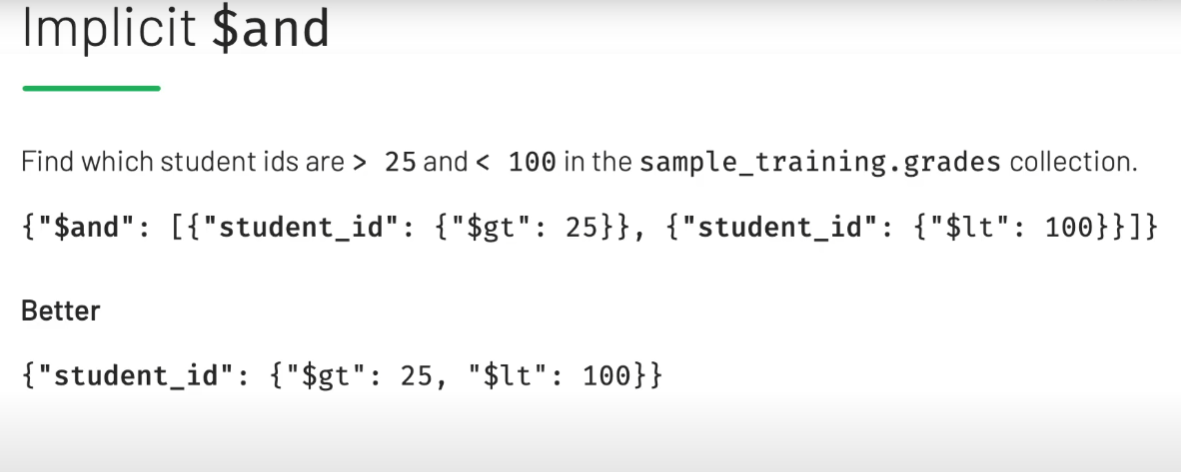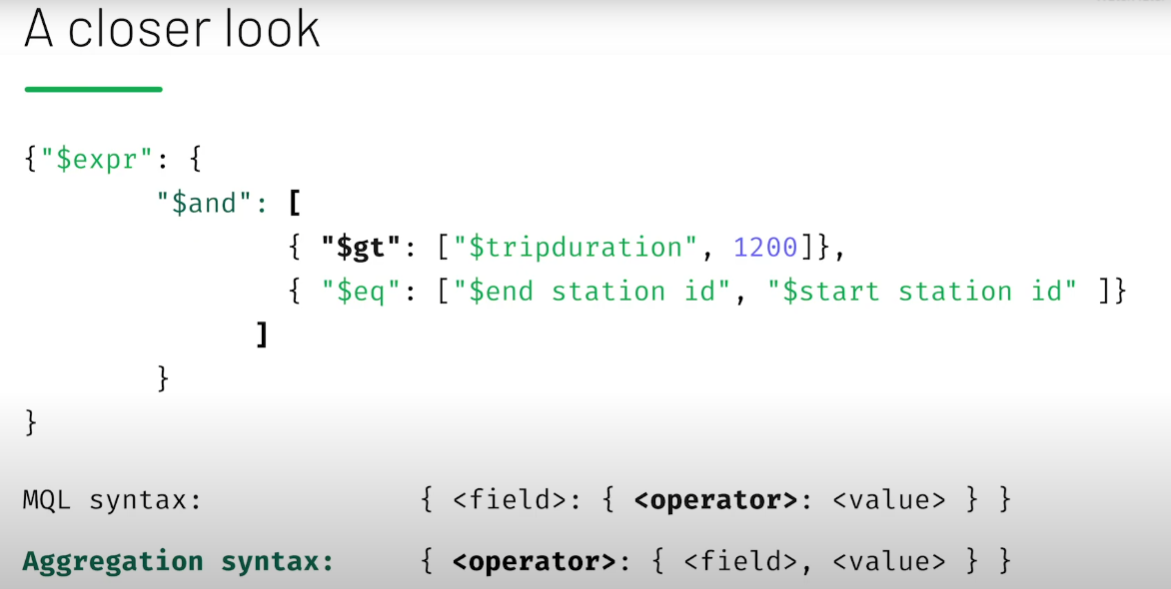Advanced CRUD operations
MQL Operators
Update Operators
Example: $inc, $set, $unset
Enable us to modify data in the database.
$ Operator
The $ operator has multiple uses:
- precedes MQL operators
- precedes aggregation pipeline stages
- allows access to field values
Query Operators
Provide additional ways to locate data within the database.
Comparison Operators
$eq(==): Equal to$ne(!=): Not equal to$gt(>): Greater than$lt(<): Less than$gte(>=): Greater than or equal to$lte(<=): Less than or equal to
Syntax to use them:
{ <field>: { <operator>: <value> } }
// Example:
{ "tripduration": { "$lte" : 60 } }
// 2 Conditions:
{ "tripduration": { "$lte" : 60 }, "usertype": { "$ne": "Subscriber" } }
With mongodb shell we can query like this:
db.trips.find({ "tripduration": { "$lte" : 70 },
"usertype": { "$eq": "Customer" }}).pretty()
// This is equivalent to (implicit equality operator):
db.trips.find({ "tripduration": { "$lte" : 70 },
"usertype": "Customer" }).pretty()
Logic Operators
$and: Match all of the specified query clauses$or: At least one of the query clauses is matched$nor: Fail to match both given clauses
Syntax:
{ <operator> : [ { statement1 }, { statement2 }, ... ] }
- $not: Negates the query requirement
Syntax:
{ $not: { statement } }
$and is the default operator
A query like this:
{ "tripduration": 60, "usertype": "Subscriber" }
already contains an implicit $and. The explicit typing looks like this:
{ "$and": [{ "tripduration": 60 }, { "usertype": "Subscriber" }] }
Another example:

Note: Explicitly use $and when you need to include the same operator more than once in a query

db.routes.find({ "$and": [ { "$or" :[ { "dst_airport": "KZN" },
{ "src_airport": "KZN" } ]
},
{ "$or" :[ { "airplane": "CR2" },
{ "airplane": "A81" } ]
}
]}).pretty()
Quizzes
Quiz 1
How many zips in the sample_training.zips dataset are neither over-populated nor under-populated?
In this case, we consider population of more than 1,000,000 to be over- populated and less than 5,000 to be under-populated.
{ "pop": { "$lt": 1000000 }, "pop": { "$gt": 5000 } }
Quiz 2
How many companies in the sample_training.companies dataset were
either founded in 2004
- [and] either have the social category_code [or] web category_code,
[or] were founded in the month of October
- [and] also either have the social category_code [or] web category_code?
{
"$or": [
{
"$and": [
{ "founded_year": 2004 },
{ "$or": [{ "category_code": "social" }, { "category_code": "web" }] }
]
},
{
"$and": [
{ "founded_month": 10 },
{ "$or": [{ "category_code": "social" }, { "category_code": "web" }] }
]
}
]
}
Expressive query operator
- $expr allows the use of aggregation expressions withing the query language
- $expr allows us to use variables and conditional statements
- Reminder: $ denotes the use of an operator or addresses the field value
Syntax:
{ $expr: { <expression> } }
Example:
Find all documents where the trip started and ended at the same station:
{ "$expr": { "$eq": [ "$end station id", "$start station id"] } }
This allows us to compare values that vary from document to document instead of one specific value.
MQL syntax vs aggregation syntax
From Github:
If all you need to do is grab a set of documents, or specific paths from documents, find is the way to go. Aggregation provides a set of operations ( stages ) which allow you to transform the data before it's returned from the server. The decision of which to use ultimately boils down to whether or not you need/want to reshape the data before returning it from the db or just returning what exists in the db as is.
Quiz
How many companies in the sample_training.companies collection have the same permalink as their twitter_username?
{ "$expr": { "$eq": ["$permalink", "$twitter_username"] } }
Array Operators
To work with array fields we can use the $all operator:
db.listingsAndReviews.find({ "amenities": {
"$size": 20,
"$all": [ "Internet", "Wifi", "Kitchen",
"Heating", "Family/kid friendly",
"Washer", "Dryer", "Essentials",
"Shampoo", "Hangers",
"Hair dryer", "Iron",
"Laptop friendly workspace" ]
}
}).pretty()
This will find all documents with exactly 20 amenities which include all the amenities listed in the query array.
Lab 1
What is the name of the listing in the sample_airbnb.listingsAndReviews dataset that accommodates more than 6 people and has exactly 50 reviews?
{ "$and": [{ "accommodates": { "$gt": 6 } }, { "reviews": { "$size": 50 } }] }
Lab 2
Using the sample_airbnb.listingsAndReviews collection find out how many documents have the "property_type" "House", and include "Changing table" as one of the "amenities"?
{
"$and": [
{ "property_type": "House" },
{ "amenities": { "$all": ["Changing table"] } }
]
}
Projection
By default, queries in MongoDB return all fields in matching documents. To limit the amount of data that MongoDB sends to applications, you can include a projection document to specify or restrict fields to return.
Syntax:
db.<collection>.find({ <query> }, { <projection> })
- 1: include the field
- 0: exclude the field
- Use only 1s or only 0s (other than excluding the _id while specifying included fields)
Example:
Find all documents with exactly 20 amenities which include all the amenities listed in the query array, and display their price and address:
db.listingsAndReviews.find({ "amenities":
{ "$size": 20, "$all": [ "Internet", "Wifi", "Kitchen", "Heating",
"Family/kid friendly", "Washer", "Dryer",
"Essentials", "Shampoo", "Hangers",
"Hair dryer", "Iron",
"Laptop friendly workspace" ] } },
{"price": 1, "address": 1}).pretty()
$elemMatch
Matches documents that contain an array field with at least one element that matches the specified query criteria or projects only the array elements with at least one element that matches the specified criteria.
Syntax:
{ <field>: { "$elemMatch": { <field>: <value> } } }
Example:
Find all documents where the student in class 431 received a grade higher than 85 for any type of assignment:
db.grades.find({ "class_id": 431 },
{ "scores": { "$elemMatch": { "score": { "$gt": 85 } } }
}).pretty()
Example 2:
Given the following documents in the scores collection:
{ _id: 1, results: [ 82, 85, 88 ] }
{ _id: 2, results: [ 75, 88, 89 ] }
The following query matches only those documents where the results array contains at least one element that is both greater than or equal to 80 and is less than 85:
db.scores.find(
{ results: { $elemMatch: { $gte: 80, $lt: 85 } } }
)
The query returns the following document since the element 82 is both greater than or equal to 80 and is less than 85:
{ "_id" : 1, "results" : [ 82, 85, 88 ] }
Lab
How many companies in the sample_training.companies collection have offices in the city of Seattle?
{ "offices.city": "Seattle" }
or $elemMatch operator allows us to specify multiple criteria on an array of embedded documents such that at least one embedded document satisfies all the specified criteria:
{ "offices": { $elemMatch: { city: "Seattle" } } }
IMPORTANT
$elemMatch is not the same logic as dot notation. $elemMatch requires the same nested elements to have the values. Using dot notation allows for any nested elements to have these values.
Example:
{ _id : 1 , array : [ { a : 1 , b : 2 } , { a : 3 , b : 3 } ] }
{ _id : 2 , array : [ { a : 1 , b : 3 } , { a : 3 , b : 4 } ] }
find( { array.a : 1 , array.b : 3 } ) // will find both documents.
find( { array : { $elemMatch : { a : 1 , b : 3 } } } ) // will only find _id:2.
More info here: Documentation
Array Operators and Sub-Documents
- Dot-notation is used to access sub documents
- With this notation we can access arbitrarily deep nested fields
Examples:
// 1 level deep
db.trips.findOne({ "start station location.type": "Point" })
// 4 levels deep (0 indicates first array element in this case)
db.companies.find({ "relationships.0.person.last_name": "Zuckerberg" },
{ "name": 1 }).pretty()
Lab 1
How many trips in the sample_training.trips collection started at stations that are to the west of the -74 longitude coordinate?
{ "start station location.coordinates.0": {"$lt": -74} }
Lab 2
How many inspections from the sample_training.inspections collection were conducted in the city of NEW YORK?
{ "address.city": "NEW YORK" }
